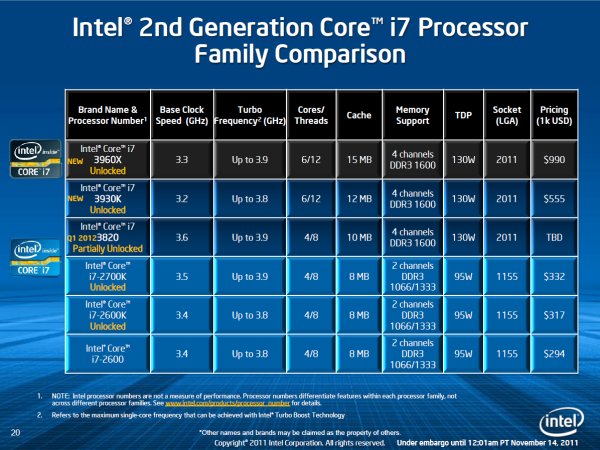Intel kick started 2011 with the release of their 2nd generation Core processors as they unleashed the Sandy Bridge architecture for the first time. Initially there were five processors, which included the popular Core i5-2500K and Core i7-2600K.
Enabling these new processors was the LGA1155 platform, which brought about three new chipsets. Two of these, the H67 and P67, went on to spoil what would have otherwise been perfect execution by Intel. Plagued by a SATA 3Gb/s bug, this put the entire platform on hold for numerous months until Intel could ramp up production of working B3 stepping chipsets to replace the defective models, effectively costing Intel a billion dollars or thereabouts.
By March the company was on the mend and before long it was all about Sandy Bridge. Intel described its production increase for the microprocessor as the fastest ramp-up of any product in the company's history.

With the Sandy Bridge processors hitting full stride, the recent release of AMD's Bulldozer processors was not enough to slow sales. This was largely due to Bulldozer's inability to compete well enough with the Core i5-2xxx series. Even worse than that, it's next to impossible to actually buy an AMD FX-8150 processor thanks to chip shortages. Meanwhile, Intel is preparing to strike back by bolstering their 2nd generation Core processors even further.
Today marks the arrival of Sandy Bridge-E and three new processors released initially, which include the Core i7-3960X Extreme Edition, Core i7-3930K and Core i7-3820. Powered by a new LGA2011 socket, these 32nm processors provide up to six cores with a dozen threads. Intel has also upgraded the integrated memory controller with four channels supporting DDR3-1600 memory, for a theoretical peak bandwidth of 51.2GB/s.

These processors will be explored in greater detail shortly, but for now it's worth mentioning they feature a total of 2.27 billion transistors in a die size of 20.8mm by 20.9mm, which are mind-boggling stats to say the least.